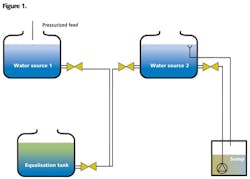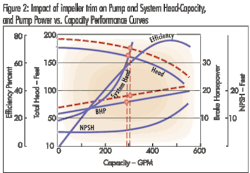Groundwater Depletion Linked to Rising Sea Levels
Groundwater resources are being depleted, sea levels are rising. Is there a link between the two? Researchers and hydrologists from Utrecht University in the Netherlands believe so. WWi looks at a report that shows groundwater depletion is most acute in India, Pakistan, the U.S. and China and why it's not just melting ice caps responsible for increasing sea levels.
Melting glaciers exascerbated by the effects of climate change are often cited as the main cause of rising sea levels. New research, however, has found there is another cause in the equation: groundwater extraction.
Large-scale groundwater extraction for irrigation, drinking water or industry has resulted in an annual rise in sea levels of approximately 0.8mm - this works out at one quarter of total annual sea-level rise (3.1mm). The remaining total can be attributed to thermal expansion (50%) and run off from glaciers and ice caps (25% approx.).
b) total groundwater abstraction for the year 2000
c) groundwater depletion for the year 2000
(all in mm a-1).
Such findings are the work of hydrologists from Utrecht University in the Netherlands, together with the International Groundwater Resources Assessment Center (IGRAC) at Deltares. They found that such a rise in sea level can be explained because "most of the groundwater extracted ultimately winds up in the sea". Runoff, evaporation and precipitation during irrigation purposes are highlighted as reasons why such quantities of groundwater end up in the sea.
Discussing the quantity of groundwater ending up in the sea, researcher Marc Bierkens, says: "This is surprisingly large when compared to the current annual rise in sea levels, which the IPCC estimates at 3.1 mm.
"Although the role of groundwater depletion in rising sea levels had already been acknowledged, it was not addressed in the most recent IPCC [Intergovernmental Panel on Climate Change] report due to a lack of reliable data to illustrate the severity of the situation. Our study confirms that groundwater depletion is, in fact, a significant factor."
In detail Research processResearchers looked at a combination of information to identify the areas in the world where groundwater extraction leads to groundwater depletion. An estimate of the amount of groundwater extracted annually in most of the world's countries could be obtained from a database of the International Groundwater Resources Assessment Centre (IGRAC), which is affiliated with Deltares. Combining this information with the estimated demand for water, based on population density and data on irrigated areas, the researchers were able to produce a map of global groundwater extraction (map 1B). A water balance model was then used to map out global groundwater aquifer recharge (map 1A), i.e. precipitation that seeps through the soil to recharge groundwater aquifers. By subtracting the figures of the groundwater extraction map from the figures of the groundwater aquifer recharge map, the researchers were able to compile a map of global groundwater depletion (see previous page).
As highlighted by Bierkens, claims that groundwater extraction is playing a part in rising sea levels are not new. Previous studies have identified groundwater depletion as a possible contributor to sea level rise but due to the uncertainty about its contributions, groundwater is not cited in many reports on rising sea levels.
For example, the IPCC Climate Change 2007 Synthesis Report stated that "possible impacts of climate change due to changes in extreme weather" include "adverse effects on quality of surface and groundwater; contamination of water supply".
Discussing the "Observed changes in climate and their effects", the IPPC at the time pointed the finger of blame towards melting ice caps for increasing sea levels.
"Warming of the climate system is unequivocal, as is now evident from observations of increases in global average air and ocean temperatures, widespread melting of snow and rising global average sea level....eleven of the last twelve years (1995-2006) rank among the twelve warmest years in the instrumentation record of global surface temperature," the report said.
It added: "Global average sea level has risen since 1961 at an average rate of 1.8 [1.3 to 2.3] mm/yr and since 1993 at 3.1 [2.4 to 3.8] mm/yr, with contributions from thermal expansion, melting glaciers and ice caps, and the polar ice sheets. Whether the faster rate for 1993 to 2003 reflects decadal variation or an increase in the longer-term trend is unclear."
Despite such comprehensive data, groundwater extraction is not mentioned as a cause for rising levels in the IPPC report. One further alarming headline from the study is the level in which groundwater abstraction is increasing. Since the 1960s, groundwater abstraction has more than doubled, according to the study. The hydrologists estimate that global groundwater extraction and depletion have increased by 312 km3 to 734 km3 and 126 km3 to 283 km3 per year, respectively, since 1960. Large abstraction rates were noted in Europe, North-East China, United States, Iran, India and Pakistan.
As can be seen from the figures, many of the well-known "hot spots" of groundwater depletion are made clear: North East Pakistan and North-West India, North-East China, the Ogallala aquifer in the central U.S., the San-Joaquin aquifer in the Central Valley of California, Iran, Yemen and the South-East of Spain.
"The study reveals that depletion is the most acute in areas of India, Pakistan, the US and China, which are also the regions without sustainable levels of food production and water consumption and which are expected to experience major problems in the long run," adds Bierkens.
Groundwater extraction is more common in more arid regions of the world, where there is less available surface water. It is used for crop irrigation, drinking water or industrial purposes.
Aquifer levels will decline if over a prolonged period more groundwater is extracted at more locations than can be replenished by means of rainwater recharge. As a consequence, rivers and wetlands will run dry and aquifer levels will fall to such a depth that pumping becomes impossible.
As the report concludes: "groundwater depletion has been increasing since the 1960s and is likely to increase further in the near future...consequently, the contribution of groundwater depletion to sea-level rise may become increasingly important in the coming decades".
More Water & WasteWater International Current Issue Articles
More Water & WasteWater International Archives Issue Articles


